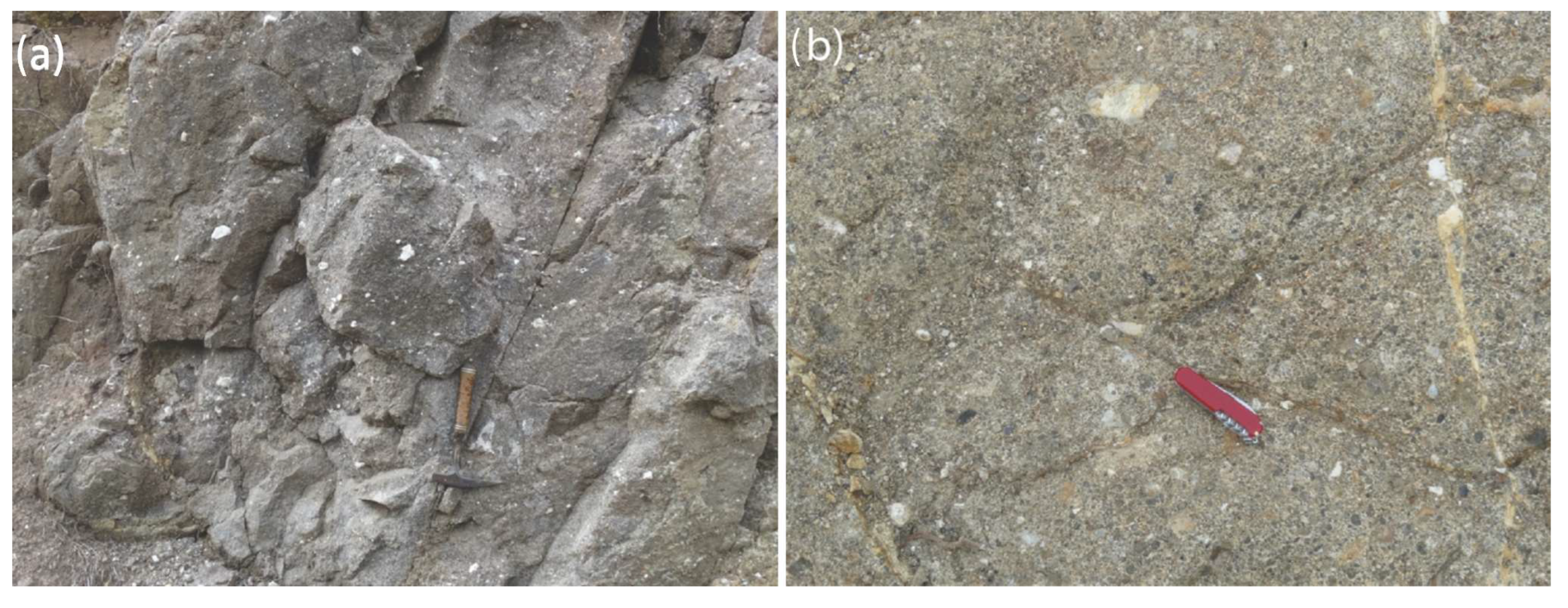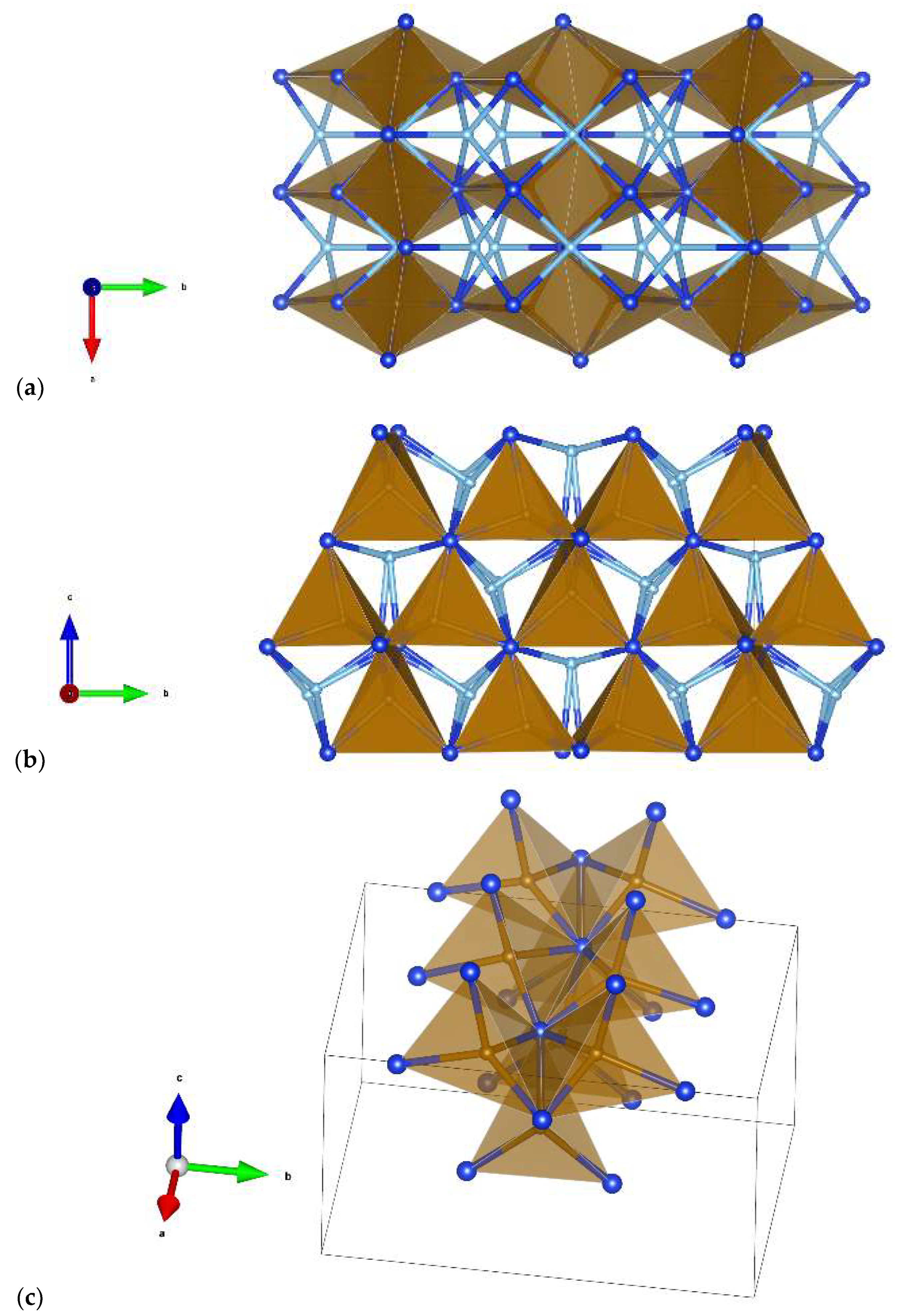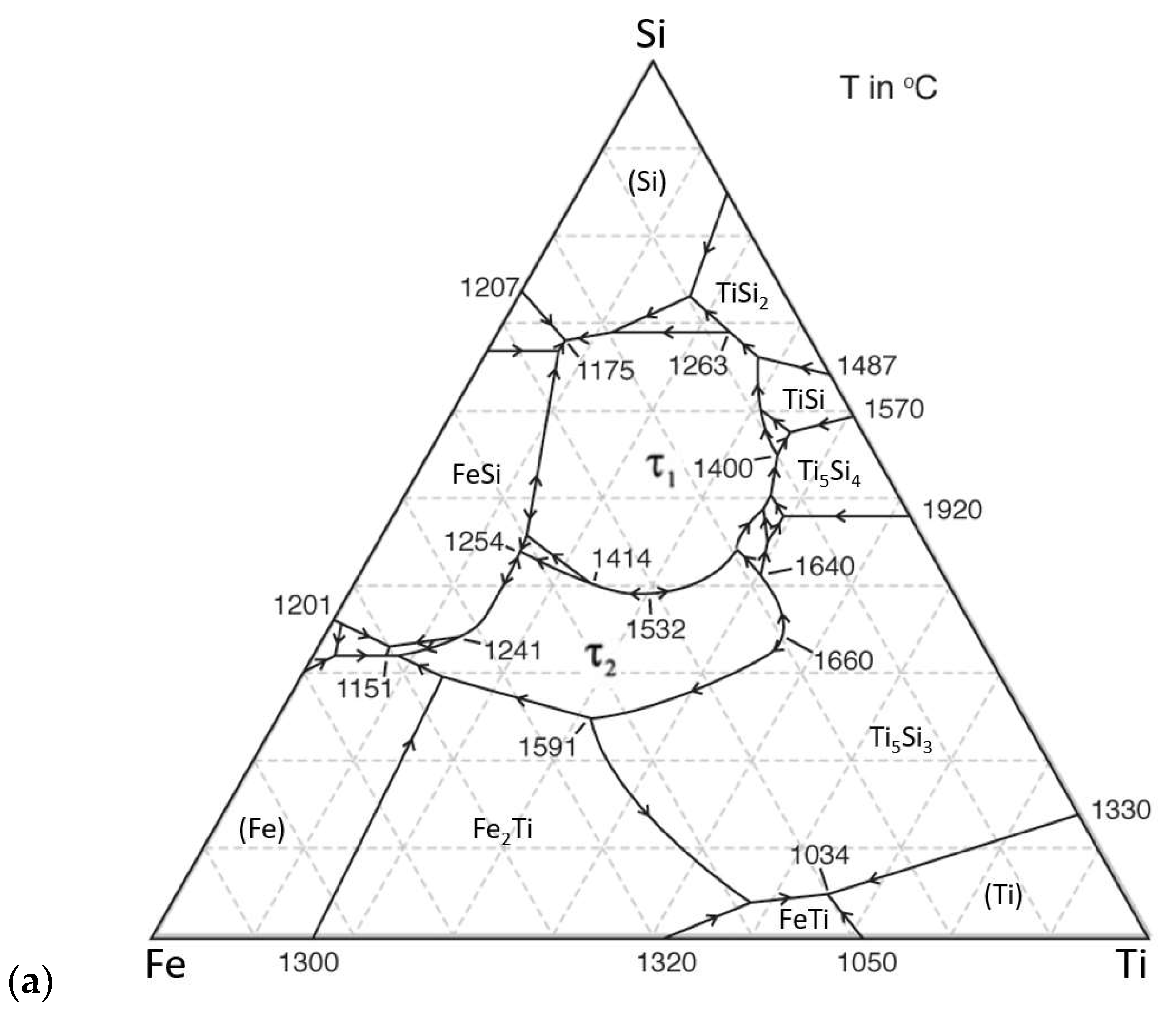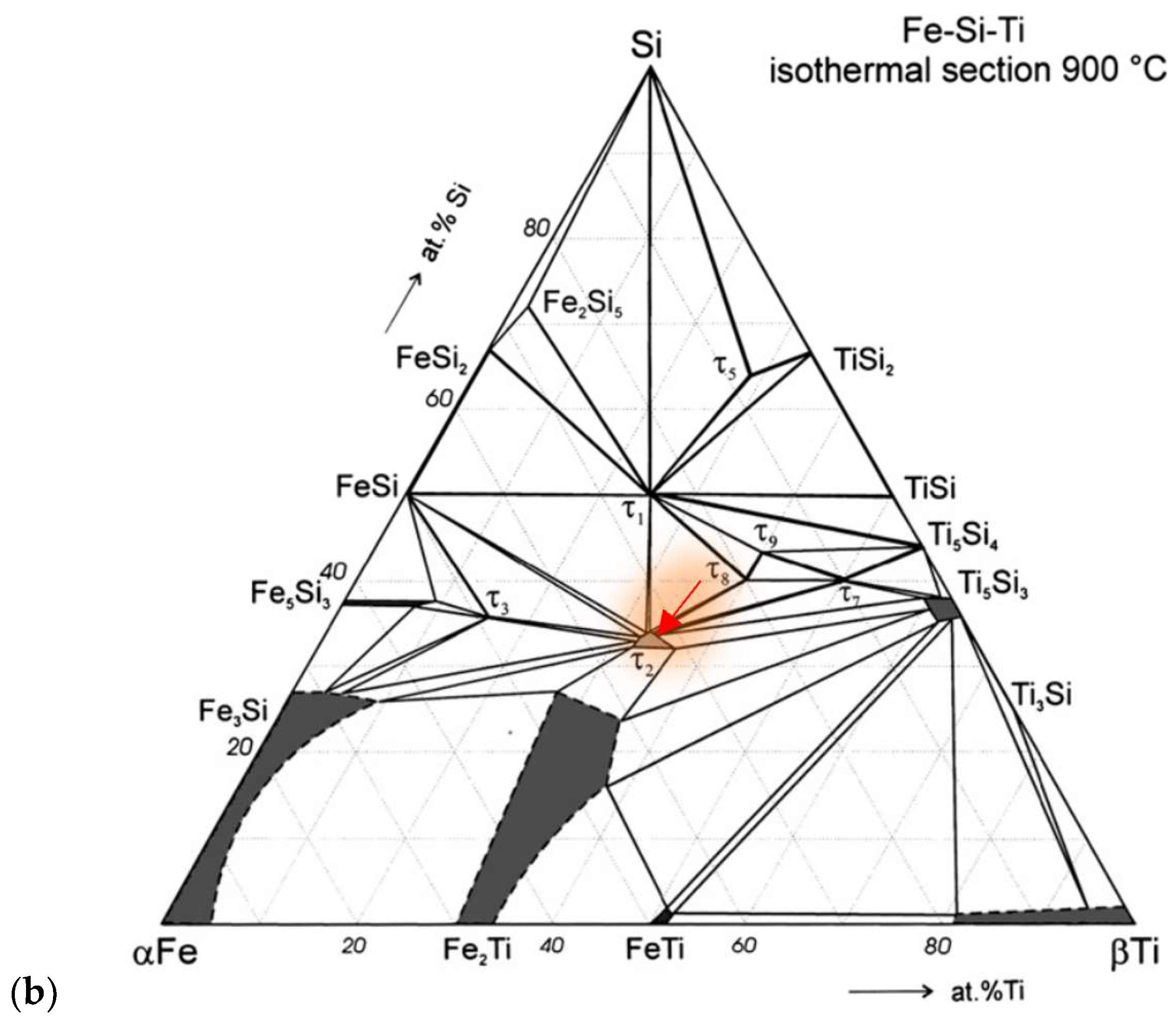Toledoite, TiFeSi, a New Mineral from Inclusions in Corundum Xenocrysts from Mount Carmel, Israel
Abstract
1. Introduction
2. Materials and Methods
3. Results
4. Discussion
5. Conclusions
Author Contributions
Funding
Data Availability Statement
Acknowledgments
Conflicts of Interest
References
- Kaminsky, F. Mineralogy of the lower mantle: A review of “super-deep” mineral inclusions in diamond. Earth Sci. Rev. 2012, 110, 127–147. [Google Scholar] [CrossRef]
- Trumbull, R.; Yang, J.-S.; Robinson, P.; Di Pierro, S.; Vennemann, T.; Wiedenbeck, M. The carbon isotope composition of natural SiC (moissanite) from the Earth’s mantle: New discoveries from ophiolites. Lithos 2009, 113, 612–620. [Google Scholar] [CrossRef]
- Dobrzhinetskaya, L.; Mukhin, P.; Wang, Q.; Wirth, R.; O’Bannon, E.; Zhao, W.; Eppelbaum, L.; Sokhonchuk, T. Moissanite (SiC) with metal-silicide and silicon inclusions from tuff of Israel: Raman spectroscopy and electron microscope studies. Lithos 2018, 310–311, 355–368. [Google Scholar] [CrossRef]
- Griffin, W.L.; Bindi, L.; Cámara, F.; Ma, C.; Gain, S.E.M.; Saunders, M.; Alard, O.; Huang, J.-X.; Shaw, J.; Meredith, C.; et al. Interactions of magmas and highly reduced fluids during intraplate volcanism, Mt Carmel, Israel: Implications for mantle redox states and global carbon cycles. Gondwana Res. 2024, 128, 14–54. [Google Scholar] [CrossRef]
- Ma, C.; Cámara, F.; Bindi, L.; Toledo, V.; Griffin, W.L. New minerals from inclusions in corundum xenocrysts from Mt Carmel, Israel: Magnéliite, ziroite, sassite, mizraite-(Ce) and yeite. Materials 2023, 16, 7578. [Google Scholar] [CrossRef]
- Ma, C.; Beckett, J.R. Kaitianite, Ti3+2Ti4+O5, a new titanium oxide mineral from Allende. Meteorit. Planet. Sci. 2021, 56, 96–107. [Google Scholar] [CrossRef]
- Litasov, K.D.; Bekker, T.B.; Kagi, H. Reply to the discussion of “Enigmatic superreduced phases in corundum from natural rocks: Possible contamination from artificial abrasive materials or metallurgical slags” by Litasov et al. (Lithos, v.340–341, p.181–190) by W.L. Griffin, V. Toledo and S.Y. O’Reilly. Lithos 2019, 348–349, 105170. [Google Scholar]
- Litasov, K.D.; Kagi, H.; Bekker, T.B. Enigmatic super-reduced phases in corundum from natural rocks: Possible contamination from artificial abrasive materials or metallurgical slags. Lithos 2019, 340–341, 181–190. [Google Scholar] [CrossRef]
- Ballhaus, C.; Helmy, H.M.; Fonseca, R.O.C.; Wirth, R.; Schreiber, A.; Jöns, N. Ultra-reduced phases in ophiolites cannot come from the Earth’s mantle. Am. Mineral. 2021, 106, 1053–1063. [Google Scholar] [CrossRef]
- Galuskin, E.; Galuskina, I. Evidence of the antoropogenic origin of the “Carmel Sapphire” with enigmatic super-reduced minerals. Min. Mag. 2023, 87, 619–630. [Google Scholar] [CrossRef]
- Galuskin, E.; Galuskina, I. Reply to the discussion of “Evidence of the anthropogenic origin of the ‘Carmel sapphire’ with enigmatic super-reduced minerals” by E. Galuskin and I. Galuskina (Mineralogical Magazine, 87, 631–634) by W.L. Griffin, V. Toledo and S.Y. O’reilly. Min. Mag. 2023, 87, 635–638. [Google Scholar] [CrossRef]
- Griffin, W.L.; Toledo, V.; O’Reilly, S.Y. Discussion of “Enigmatic super-reduced phases in corundum from natural rocks: Possible contamination from artificial abrasive materials or metallurgical slags” by Litasov et al. Lithos 2019, 348–349, 105122. [Google Scholar] [CrossRef]
- Griffin, W.L.; Toledo, V.; O’Reilly, S.Y. Discussion of paper by Galuskin and Galuskina, “Evidence of the anthropogenic origin of the “Carmel Sapphire” with enigmatic super-reduced minerals”. Min. Mag. 2023, 87, 631–634. [Google Scholar] [CrossRef]
- Griffin, W.L.; Gain, S.E.M.; Huang, J.-X.; Belousova, E.A.; Toledo, V.; O’Reilly, S.Y. Permian to Quaternary magmatism beneath the Mt Carmel area, Israel: Zircons from volcanic rocks and associated alluvial deposits. Lithos 2018, 314–315, 307–322. [Google Scholar] [CrossRef]
- Yu, Z. Two new minerals gupeiite and xifengite in cosmic dusts from Yanshan. Acta Petrol. Mineral. Et Anal. 1984, 3, 231–238. [Google Scholar]
- Xiong, F.; Xu, X.; Mugnaioli, E.; Gemmi, M.; Wirth, R.; Grew, E.S.; Robinson, P.T. Jingsuiite, TiB2, a new mineral from the Cr-11 podiform chromitite orebody, Luobusa ophiolite, Tibet, China: Implications for recycling of boron. Am. Mineral. 2022, 107, 43–53. [Google Scholar] [CrossRef]
- Story-Maskelyne, M.H.N.X. On the mineral constituents of meteorites. Phil. Trans. R. Soc. 1870, 160, 189–214. [Google Scholar]
- Shi, N.; Bai, W.; Li, G.; Xiong, M.; Yang, J.; Ma, Z.; Rong, H. Naquite, FeSi, a new mineral species from Luobusha, Tibet, Western China. Acta Geol. Sin. 2012, 86, 533–538. [Google Scholar]
- Jeitschko, W. The crystal structure of TiFeSi and related compounds. Acta Crystallogr. B Struct. Crystallogr. Cryst. Chem. 1970, 26, 815–822. [Google Scholar] [CrossRef]
- Baur, W.H. The Geometry of Polyhedral Distortions. Predictive Relationships for the Phosphate Group. Acta Crystallogr. B Struct. Crystallogr. Cryst. Eng. Mater. 1974, 30, 1195–1215. [Google Scholar] [CrossRef]
- Li, G.; Fang, Q.; Shi, N.; Bai, W.; Yang, J.; Xiong, M.; Ma, Z.; Rong, H. Zangboite, TiFeSi2, a new mineral species from Luobusha, Tibet, China, and its crystal structure. Can. Mineral. 2009, 47, 1265–1274. [Google Scholar]
- Momma, K.; Izumi, F. VESTA 3 for three-dimensional visualization of crystal, volumetric and morphology data. J. Appl. Crystallogr. 2011, 44, 1272–1276. [Google Scholar] [CrossRef]
- Wolfgang, J. Ternary phases with TiFeSi and ordered Fe2P type structures. Metall. Trans. 1970, 1, 2963–2965. [Google Scholar]
- Weitzer, F.; Schuster, J.C.; Naka, M.; Stein, F.; Palm, M. On the reaction scheme and liquidus surface in the ternary system Fe-Si-Ti. Intermetallics 2008, 16, 273–282. [Google Scholar] [CrossRef]
- Marshall, M.; Sanford, J.; Shelton, W.; Xie, W. The crystal structures and magnetic properties of TiFeSi coexisting in hexagonal and orthorhombic symmetries. J. Alloys Compd. 2021, 864, 158617. [Google Scholar] [CrossRef]
- Griffin, W.L.; Gain, S.E.M.; Saunders, M.; Huang, J.-X.; Alard, O.; Toledo, V.; O’Reilly, S.Y. Immiscible metallic melts in the upper mantle beneath Mount Carmel, Israel: Silicides, phosphides and carbides. Am. Mineral. 2022, 107, 532–549. [Google Scholar] [CrossRef]
- Xiong, F.; Xu, X.; Mugnaioli, E.; Gemmi, M.; Wirth, R.; Grew, E.S.; Robinson, P.T.; Yang, J. Two new minerals, badengzhuite, TiP, and zhiqinite, TiSi2, from the Cr-11 chromitite orebody, Luobusa ophiolite, Tibet, China: Is this evidence for super-reduced mantle-derived fluids? Eur. J. Mineral. 2020, 32, 557–574. [Google Scholar] [CrossRef]
- Xiong, F.; Xu, X.; Mugnaioli, E.; Gemmi, M.; Wirth, R.; Yang, J.; Grew, E.S. Wenjiite, Ti10(Si,P,□)7, and kangjinlaite, Ti11(Si,P)10, new minerals in the ternary Ti-P-Si system from the Luobusa ophiolite, Tibet, China. Am. Mineral. 2023, 108, 197–210. [Google Scholar] [CrossRef]
- Mandal, P. Structural disorder in Ti–Fe–Si icosahedral quasicrystal. J. Alloys Compd. 2003, 361, 96–101. [Google Scholar] [CrossRef]






| Constituent | Mean | Range | SD | Probe Standard |
|---|---|---|---|---|
| Fe | 40.47 | 39.92–41.17 | 0.37 | Fe metal |
| Ti | 29.94 | 29.39–30.84 | 0.47 | Ti metal |
| Si | 20.83 | 20.29–21.29 | 0.25 | Si metal |
| Mn | 3.96 | 3.69–4.14 | 0.11 | Mn2SiO4 |
| Cr | 2.73 | 2.54–2.91 | 0.10 | Cr metal |
| V | 0.77 | 0.71–0.85 | 0.04 | V metal |
| P | 0.82 | 0.71–1.24 | 0.17 | GaP |
| Total | 99.52 |
| h | k | l | d [Å] | Irel |
|---|---|---|---|---|
| 1 | 1 | 0 | 5.8789 | 1 |
| 0 | 1 | 1 | 5.4392 | 6 |
| 0 | 2 | 0 | 5.4150 | 3 |
| 1 | 2 | 1 | 3.5402 | 1 |
| 2 | 0 | 0 | 3.5000 | 5 |
| 0 | 0 | 2 | 3.1450 | 3 |
| 0 | 3 | 1 | 3.1310 | 5 |
| 2 | 1 | 1 | 2.9433 | 7 |
| 2 | 2 | 0 | 2.9394 | 4 |
| 0 | 2 | 2 | 2.7196 | 3 |
| 0 | 4 | 0 | 2.7075 | 1 |
| 1 | 4 | 1 | 2.3434 | 1 |
| 2 | 0 | 2 | 2.3393 | 44 |
| 2 | 3 | 1 | 2.3335 | 100 |
| 3 | 1 | 0 | 2.2810 | 4 |
| 1 | 3 | 2 | 2.2460 | 3 |
| 2 | 2 | 2 | 2.1475 | 89 |
| 2 | 4 | 0 | 2.1415 | 38 |
| 1 | 5 | 0 | 2.0692 | 4 |
| 0 | 1 | 3 | 2.0585 | 36 |
| 0 | 4 | 2 | 2.0519 | 33 |
| 0 | 5 | 1 | 2.0480 | 34 |
| 3 | 2 | 1 | 2.0284 | 8 |
| 3 | 3 | 0 | 1.9596 | 2 |
| 1 | 2 | 3 | 1.8831 | 2 |
| 3 | 1 | 2 | 1.8465 | 4 |
| 0 | 3 | 3 | 1.8131 | 17 |
| 0 | 6 | 0 | 1.8050 | 8 |
| 2 | 1 | 3 | 1.7743 | 12 |
| 2 | 4 | 2 | 1.7701 | 12 |
| 2 | 5 | 1 | 1.7676 | 11 |
| 4 | 0 | 0 | 1.7500 | 36 |
| 3 | 4 | 1 | 1.7016 | 1 |
| 1 | 6 | 1 | 1.6840 | 1 |
| 3 | 3 | 2 | 1.6632 | 2 |
Disclaimer/Publisher’s Note: The statements, opinions and data contained in all publications are solely those of the individual author(s) and contributor(s) and not of MDPI and/or the editor(s). MDPI and/or the editor(s) disclaim responsibility for any injury to people or property resulting from any ideas, methods, instructions or products referred to in the content. |
© 2024 by the authors. Licensee MDPI, Basel, Switzerland. This article is an open access article distributed under the terms and conditions of the Creative Commons Attribution (CC BY) license (https://creativecommons.org/licenses/by/4.0/).
Share and Cite
Ma, C.; Cámara, F.; Bindi, L.; Griffin, W.L. Toledoite, TiFeSi, a New Mineral from Inclusions in Corundum Xenocrysts from Mount Carmel, Israel. Crystals 2024, 14, 96. https://doi.org/10.3390/cryst14010096
Ma C, Cámara F, Bindi L, Griffin WL. Toledoite, TiFeSi, a New Mineral from Inclusions in Corundum Xenocrysts from Mount Carmel, Israel. Crystals. 2024; 14(1):96. https://doi.org/10.3390/cryst14010096
Chicago/Turabian StyleMa, Chi, Fernando Cámara, Luca Bindi, and William L. Griffin. 2024. "Toledoite, TiFeSi, a New Mineral from Inclusions in Corundum Xenocrysts from Mount Carmel, Israel" Crystals 14, no. 1: 96. https://doi.org/10.3390/cryst14010096
APA StyleMa, C., Cámara, F., Bindi, L., & Griffin, W. L. (2024). Toledoite, TiFeSi, a New Mineral from Inclusions in Corundum Xenocrysts from Mount Carmel, Israel. Crystals, 14(1), 96. https://doi.org/10.3390/cryst14010096








